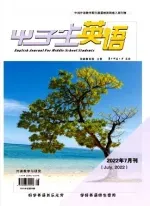英语学习的过程是自我建构、自我生成的过程
河北省邯郸市磁县讲武城中学 李春燕
学习是学生主动建构知识的过程。学生不是简单被动地接受信息,而是对外部信息进行主动地选择,加工和处理,从而获得知识。学习的过程是自我生成的过程,这种生成是他人无法取代的,是由内向外的生长,而不是由外向内的灌输,其基础是学生原有的知识与经验。
一、注重学生原有的知识
如课例:Find The Right Place教学片段 (教师提供一幅Lily的房间陈列图)
T:I have a little friend,her name is Lily,She is a nice girl,but she always forgets things.She can’t find her shoes,she can’t find her bag.Can you help her?
S:Yes.
T:Where’re her school clothes?
S:They’er on the bed.
T:Where’re her shoes?
S:Ther’re under the bed.
T:Where’re her English book?Can you find it on the desk?
S:No,it’s in her school bag.
T:Maybe.Thank you.Lily can find her things now,and she can go to school.Where’s her school?
(教师展示事先准备好的位置示意图,通过school作为过渡,引出本课出现的新的地点名词,并帮助学生说出它们的方位)
T:Look at this Pictuer.What place is it?It’s a bank...Say after me,bank.(学生读准后)
T:Where’s the bank?
S:It’s next to the school.
T:And you send letters to your friends in this place.Well call it a post office.(带读)
T:Can you find the post office in the map?
S:Yes,it’s front of the...
本课例的教学重点有两个:一是next to,in front of,behind,outside,on the left,on the right等介词和词组的用法;二是本课新出现的地点名词。在呈现新知识之前,教师先通过帮Lily找物品的游戏,激活了学生原有的知识。具体地说,一是学生已经学过的介词in,on,under等,为将要学习的新介词和词组提供借鉴。二是通过学生已经非常熟悉的school一词,逐渐介绍bank,post office等,并穿插介绍它们的位置,使学生在原有知识的基础上,逐渐引伸、生成新的知识来。
二、注重学生的经验
在以往的教学中我们更容易忽略的是学生的经验。经验是人与客观世界之间的交互作用与相互影响,它既是经验的过程,也是经验的结果,是经验的过程与结果的统一;它既指经验着(过)的事物,也指经验着(过)的感受,是经验着(过)的事物和感受的统一。 如课例:“You Must Be More Careful”教学片段。
T:How do you usually go to school?
S:By bike.
T:You must be more careful when you cross the road.
S:OK.Thank you.
T:Then please tell me what we should do when we cross the street.(板书:When we cross the street...)
S1:When we cross the street.We must stop and look left and right carefully.
S2:When we cross the street,We must’t run.
S3:...
T:That’s vety good.When you see the light for walkers,you should stop and wait.
And when the green light is on,you can go.What should we do if there’s a lot of traffic?
T:(板书:If...)
S1:We must stop.
T:If you are not careful enough...
S2:If I am not carefulenough,a car may hit me.
T:If a man drives too fast...
S3:If he drives too fast,he may have an accident.
(然后提供一组图片,让学生通过看图说话进一步灵活运用when和If)
本课例中,教师依据学生在生活中天天都有过马路的生活体验,在导入阶段,教师似乎是在了解学生的日常学习和生活,实际上是在把when和if的用法和意义带出,让学生在一定的语言环境中理解它们的意义和用法。接着就马上把练习的机会交给了学生。对于教师提出的两个开放性问题Please tell me what we should do when we cross the street.What should we do if there’s a lot of traffic?由于学生有着丰富的经验,谈论起来不会存在太大的困难,会非常乐意参与进去。所以说,学生的经验也是学习的重要基础,在教学中要给予足够的重视。
[1]教育部.义务教育英语课程标准[M].北京:人民教育出版社,2007.

